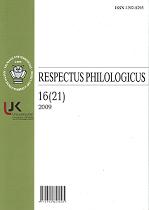BENDRINĖS LIETUVIŲ KALBOS GARSŲ DAŽNUMAS
PHONE FREQUENCY IN STANDARD LITHUANIAN
Author(s): Asta Kazlauskienė, Gailius RaškinisSubject(s): Language and Literature Studies
Published by: Vilniaus Universiteto Leidykla
Keywords: garsas1; fonema; balsis2; priebalsis3; dvigarsis4; vartojimo dažnumas5;
Summary/Abstract: The frequencies of Lithuanian phonemes and letters have been extensively studied and described, whereas studies of the frequencies of Lithuanian phones have not received so much attention. The present study aims at describing frequencies of Lithuanian phones in contemporary speech. In this study, complex diphthongs (ie, uo) and affricates (c, č, dz, dž) are considered to be separate indivisible phonemic segments (independent phonemes), and the second constituent of the compound diphthongs (ai, au, ei, ui, ou, oi) is treated as a vowel (i, u). Experimental data consists of nearly 108 thousand of phonological words which are made up of 742 920 phone entities. Experimental data was prepared by automatically stressing, syllabifying and phonetically transcribing various texts. Software tools developed at VMU were used for this purpose. Phonetic transcription took into account phonetic properties of standard Lithuanian such as consonant assimilation, gemination, word-initial and word-closing pronunciation regularities. The investigations showed that monophthongs make up 89% of all phones. Vowels and consonants make up 36% and 53% of all monophthongs respectively. Other phones (11%) may have different functional interpretations. They are complex diphthongs (1,7%), affricates (1%), compound diphthongs (3,4%), and semi-diphthongs (4,6%). Consonants (including monophthongs, the second constituent of semi-diphthongs, and affricates) are 1.2 times more frequent than vowels (including monophthongs, complex diphthongs, the first and the second constituent of compound diphthongs, and the first constituent of semi-diphthongs). Front and back vowels are equally frequently pronounced. High and low vowels are almost equally frequently pronounced too. High and low vowels make up four fifths of all vowels, whereas mid vowels make up less than one fifth of all vowels. Short vowels are 1.6 times more frequent than long ones. Unstressed monophthongs are more than twice frequent than stressed ones. Smooth rising accent is twice as frequent as sharp falling accent among stressed monophthongs. Frequency ratio among sonorants, plosives and fricatives is 2:1,8:1 respectively. Frequency ratio among labiodentals, mid-consonants (palatal), back-consonants, bilabials, alveolar and dentals is 1:1.6:2:3.2:3.6:8.6 respectively. Nearly two thirds (61%) of consonants are either dental or alveolar. Non palatalized consonants are 1.2 times more frequent than palatalized ones. Voiced plosives and fricatives are 3.4 times more frequent than their respective unvoiced counterparts. This study confirms earlier established regularities in relative phone frequencies. Different results of this study are obtained just because of different interpretations given to some phonetic elements.
Journal: Respectus Philologicus
- Issue Year: 2009
- Issue No: 16 (21)
- Page Range: 169-182
- Page Count: 14
- Language: Lithuanian

